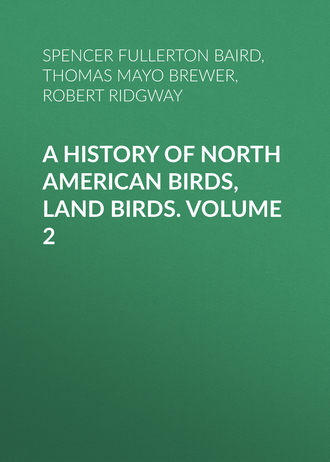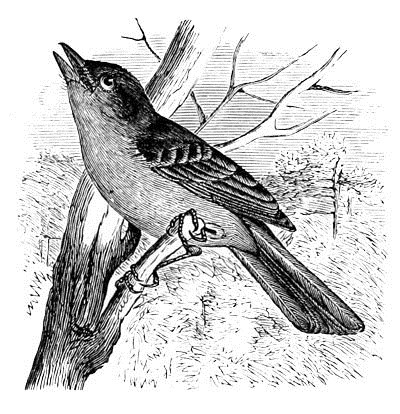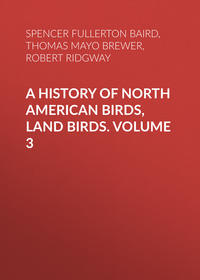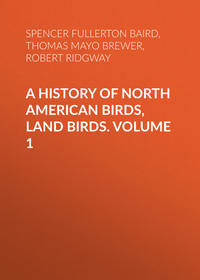 полная версия
полная версияA History of North American Birds, Land Birds. Volume 2
Mr. Ridgway did not meet with this species anywhere in the Great Basin, nor in the Sacramento Valley. On the plains it is found as far north as Cheyenne and Laramie Peak, and in the southern portion of the Western Provinces extends westward to California.
Specimens were obtained by Mr. George M. Skinner from Salamá, Vera Paz, in Central America. It was also taken, in February, near Oaxaca, Mexico, by Mr. Boucard.
A nest of this bird (No. 1,828), in the Smithsonian Museum, was taken at Volcan de Colima, June, 1863, by Mr. John Xantus. It is a slight structure composed chiefly of wiry grass, mixed with bits of wool, and lined with finer grasses. The eggs are two in number, having a pure-white ground, freckled on the larger end with purplish-brown and grayish-lilac. These markings are more sparse and are finer than those of the eggs of any other species of this genus, so far as I am aware. One of the eggs has a few blotches of umber on the larger end. They measure, one .93 by .68 of an inch, the other .93 by .65.
Tyrannus melancholicus, var. couchi, BairdCOUCH’S KINGBIRDTyrannus couchi, Baird, Birds N. Am. 1858, 175, pl. xlix, f. 1.—Scl. Catal. Am. B. 1862, 235.
Sp. Char. Bill long as the head. Feet stout. Five outer primaries abruptly attenuated at the end; the third and fourth longest; the first a little longer than the sixth. Tail considerably forked (depth of fork about .30 of an inch, or more). Head, neck, and jugulum bluish-ashy, becoming nearly white on the throat, and shaded with yellow on the breast. Rest of lower parts gamboge-yellow. Rest of upper parts olive-green, tinged with ash anteriorly. Tail and primaries grayish-brown, the tail not the darker. Wing-coverts passing externally into pale, the tertials edged with almost white. Crown with a concealed patch of bright orange-red. Length, 9.00; wing, 5.00; tail, 4.70.
Hab. Middle America (both coasts), from southern border of United States, south to Guatemala; Tucson, Arizona (Bendire).
All specimens of T. melancholicus from regions north of Guatemala are referrible to var. couchi; all from Costa Rica southward, to melancholicus.
It is only by comparing specimens from near the extreme northern and southern limits of the range of the species, that differences are readily discernible; and between these two extremes there is so gradual a transition that it is impossible to draw a line separating two well-marked varieties, so that it is necessary to assume an arbitrary geographical line, and determine specimens from the middle regions by their position, whether to the north or south of the line established. Specimens from Buenos Ayres, the Parana, and Brazil, to Peru and New Granada, are identical. Costa Rica specimens (T. satrapa, Licht.) have the dark tail of var. melancholicus and white throat of couchi.
Genus MYIARCHUS, CabanisMyiarchus, Cabanis, Fauna Peruana, 1844-46, 152.—Burmeister, Thiere Brasiliens, II, Vögel, 1856, 469.
Gen. Char. Tarsus equal to or not longer than the middle toe, which is decidedly longer than the hinder one. Bill wider at base than half the culmen. Tail broad, long, even, or slightly rounded, about equal to the wings, which scarcely reach the middle of the tail; the first primary shorter than the sixth. Head with elongated lanceolate distinct feathers. Above brownish-olive, throat ash, belly yellow. Tail and wing feathers varied with rufous.
This genus is well marked among the American Flycatchers, and constitutes what Bonaparte called Ultimi Tyrannorum sive Tyrannularum primæ. The type is the Muscicapa ferox of Gmelin, (M. tyrannulus,) which, as identified by Cabanis and Burmeister as above, appears to resemble our species very closely.

Myiarchus mexicanus.
1449
For an elaborate discussion of the various forms of this exceedingly difficult genus, we are indebted to a recent monograph by Dr. Coues, in the Proceedings of the Philadelphia Academy, for June and July, 1872 (pp. 56-81). With the same material for our investigations, we have been led, after a very careful perusal of the valuable paper mentioned, and tedious critical comparison of the large material at our command, to adopt a somewhat difficult view of the relationship of the forms characterized. The following synopsis expresses their affinity as at present understood:—
Common Characters. Above olivaceous, usually uniform, sometimes darker, sometimes more ashy, on the head above. Head and jugulum more or less ashy, though the latter is sometimes very pale. Rest of lower parts sulphur-yellow, sometimes almost or quite white. Primaries, secondaries, and rectrices usually more or less edged on either web with rufous; but sometimes entirely destitute of this color.
Species and VarietiesA. Bill sub-conical; sometimes nearly terete, its depth equal to, or exceeding, its breadth in the middle portion; its lateral outlines moderately divergent basally; terminal hook abrupt, strong. (Myionax.)
1. M. tyrannulus. No trace of rufous edgings on either wings or tail. Above ashy-olive, the pileum similar, the outer webs of wing-coverts and secondaries edged with whitish. Head, laterally and beneath, ashy, the throat and jugulum more whitish; rest of lower parts sulphur-yellow. Tail slightly rounded.
Pileum and nape umber-brown; upper surface umber-grayish. Bill dark brown. Wing, 3.50-3.70; tail, 3.60-3.90; culmen, .90-.95; tarsus, .80-.90. Hab. South and Central America, from Bolivia and Southern Brazil to Costa Rica … var. tyrannulus.66
Whole head and neck pure ash, paler on the throat, and darker on the pileum; upper surface greenish-ash. Bill black. Wing, 3.70; tail, 4.00; culmen, .82; tarsus, .91. Hab. Ecuador and Guayaquil … var. phæocephalus.67
2. M. validus.68 All the wing-coverts, tertials, secondaries, primaries, and rectrices distinctly edged with rufous (the latter on both webs). Above olivaceous, more ashy anteriorly; the upper tail-coverts more rufescent; remiges broadly rufous on exterior edges; rectrices with the whole inner web (except a narrow streak along the shaft) and edge of outer web rufous. Head beneath, and entire throat and breast, deep ash; rest of lower parts sulphur-yellow, the junction of the two colors not well defined. Wing, 3.80-4.20; tail, 3.80-4.20; culmen, 1.00; tarsus, .80-91; tail even; third and fourth quill longest. Hab. Jamaica.
3. M. crinitus. Outer webs of primaries distinctly edged with rufous (no other rufous on wings); inner webs of rectrices broadly, sometimes entirely, rufous, none on outer webs (except in young). Above olivaceous, varying from a greenish to an ashy cast, the pileum more brownish. Wing-coverts (both rows) broadly tipped with brownish ashy-whitish; tertials, secondaries, and lateral tail-feather broadly edged on outer web with the same. Head laterally and beneath ashy paler on the throat and jugulum; rest of lower parts delicate yellow, varying from a rich lemon to a pale sulphur tint. Hab. Continental America.
Bill dark brown (never black). Upper parts decidedly greenish; ash of throat and jugulum, and yellow of abdomen, etc., very deep.
Inner webs of rectrices wholly rufous, or with only a narrow strip of dusky along the shaft. Wing, 3.75-4.25; tail, 3.75-4.20; culmen, .95-1.00; tarsus, .85-.90. Hab. Eastern Province of North America; in winter south through Eastern Mexico to Guatemala (grading into var. irritabilis in Nicaragua) … var. crinitus.
Bill deep black; upper parts without a greenish, but, instead, an ashy-brownish cast; ash of throat and jugulum, and yellow of abdomen, etc., very pale.
Inner webs of rectrices broadly (but not entirely) rufous to the extreme tip, with a broad dusky stripe next the shaft.
Wing, 4.10-4.50; tail, 4.00-4.70; culmen, 1.10-1.20; tarsus, 1.00-1.05. Hab. Southern and Western Mexico (Tehuantepec, Yucatan, Mazatlan, etc.) … var. cooperi.69
Wing, 3.60-3.90; tail, 3.50-3.75; culmen, .90-1.00; tarsus, .80-.85. Hab. Eastern South America, and Central America, from Paraguay to Costa Rica (grading into var. cooperi in Guatemala, and into var. cinerascens in Tehuantepec) … var. irritabilis.70
Inner webs of rectrices almost entirely rufous to near the extreme tip, the end of the web, however, being brownish-dusky like the outer.
Wing, 3.35-4.10; tail, 3.35-4.10; culmen, .80-1.00; tarsus, .80-.91. Hab. Western Province of United States, and Western Mexico (grading into var. irritabilis in Tehuantepec, and in winter migrating into Eastern Mexico) … var. cinerascens.
4. M. stolidus. Colors essentially nearly as the varieties of M. crinitus. Primaries more or less distinctly edged with rufous, especially on inner quills; rectrices with inner webs more or less edged with rufous (found only terminally in var. antillarum). Wing-coverts broadly tipped with dull ashy-whitish. Above brownish-slaty, with an olivaceous cast, the pileum more or less appreciably darker. Beneath ashy-white, without distinct yellow (except in var. stolidus, in which the abdomen, etc., are pale sulphury yellow). Tail varying in shape from slightly rounded to distinctly emarginated. Hab. West Indies.
Beneath entirely white, only faintly, or hardly appreciably, tinged with sulphur-yellow on the flanks.
Inner web of rectrices broadly edged with rufous for the whole length. Crown scarcely darker than the back. Tail distinctly emarginated. Wing, 3.15-3.50; tail, 3.30-3.60; culmen, .85-.95; tarsus, .80-85. (Bahaman specimens the larger). Hab. Bahamas and Cuba … var. phœbe.71
Inner web of rectrices not edged with rufous except at extreme tip, where sometimes also absent. Crown decidedly darker than the back. Tail slightly rounded. Wing, 3.25-3.50; tail, 3.20-3.60; culmen, .85-95; tarsus, .85-90. Hab. Porto Rico … var. antillarum.72
Beneath white only on throat and jugulum, the abdomen, etc., being sulphur-yellow.
Inner webs of rectrices more or less distinctly edged with rufous for whole length. Pileum very much darker than the back. Wing, 3.35-3.50; tail, 3.35-3.65; culmen, .90-.95; tarsus, .80-.85. Tail faintly doubly-rounded. Hab. Hayti, Jamaica, (and Yucatan?) … var. stolidus.73
B. Bill much depressed, its depth only about half its width, in the middle portion; lateral outlines widely divergent basally; terminal hook weak. (Myiarchus.)
5. M. tristis. Colors very variable, and amount of rufous exceedingly different in the different races. Inner webs of rectrices seldom edged with rufous; rufous sometimes entirely absent on both wings and tail, and sometimes the whole wing and both webs of rectrices distinctly edged with it. Above ashy-olive, usually with more or less of a greenish cast, the pileum decidedly darker (except in var. lawrencei); throat and jugulum ashy-white; rest of lower parts sulphur-yellow. Hab. Central and South America, and Jamaica.
Pileum sooty-brown, decidedly darker than the back; wings and tail entirely destitute of rufous edgings, except a faint tinge on outer webs of inner secondaries and rectrices, towards the base. Tail faintly rounded. Wing, 3.00; tail, 3.10; culmen, .80; tarsus, .65. Hab. Jamaica … var. tristis.74
Pileum grayish-brown, not appreciably darker than the back; outer webs of inner secondaries and primaries and rectrices faintly edged with rufous. Wing, 2.80-3.40; tail, 2,85-3.45; culmen, .85-.90; tarsus, .75-.80. Hab. Northern Mexico, from northern boundary, south to Colima, Tehuantepec, Yucatan, and Salvador … var. lawrencei.75
Pileum sooty-blackish, decidedly and abruptly darker than the back. Outer webs of wing-coverts, primaries, secondaries, and rectrices distinctly edged with rufous. Yellow beneath brighter than in lawrencei. Wing, 3.20-3.30; tail, 3.15-3.30; culmen, .80-.85; tarsus, .75-.80. Hab. Central America from Panama to Guatemala (grading into var. lawrencei in Tehuantepec, and Orizaba) … var. nigricapillus.76
Pileum deep black, abruptly different from the greenish-olive of the back, and separated from it by a more ashy shade. Wings and tail wholly destitute of rufous edgings. Yellow beneath brighter than in var. nigricapillus. Wing, 3.20; tail, 3.20; culmen, .85; tarsus, .78. Tail about even. Hab. Northwest South America, from Ecuador northward (grading into nigricapillus on Isthmus of Panama) … var. nigriceps.77
Myiarchus crinitus, CabanisGREAT CRESTED FLYCATCHERMuscicapa crinita, Linn. Syst. Nat. I, 1766, 325.—Wilson, Am. Orn. II, 1810, 75, pl. xiii.—Licht. Verzeichniss Doubl. 1823, No. 559.—Aud. Orn. Biog. II, 1834, 176; V, 423, pl. cxxix.—Ib. Birds Am. I, 1840, 209, pl. lvii. Tyrannus crinitus, Swainson, Mon. Tyrant Shrikes in Quarterly Journal, XX, Jan. 1826, 271.—Nuttall, Man. I, (2d ed.,) 1840, 302.—Max. Cab. J. VI, 1858, 182. Myiobius crinitus, Gray, Genera, I, 248. Tyrannula crinita, Bonap. Consp. 1850, 189.—Kaup, Pr. Zoöl. Soc. 1851, 51. Myiarchus crinitus, Cabanis, Journ. für Ornith. III, 1855, 479.—Baird, Birds N. Am. 1858, 178.—Scl. Catal. 1862, 232.—Samuels, 131. Myionax crinitus, Caban. Mus. Hein. 1859, 73 (type, Journ. 1861, 250). Muscicapa ludoviciana, Gm. Syst. Nat. I, 1788, 934.—Latham, Ind. Tyrannus ludovicianus, Vieillot, Ois. Am. Sept. I, 1807, pl. xlv. Muscicapa virginiana cristata, Brisson, II, 1760, 412. Crested Flycatcher, Pennant, Latham.
Figure: Buffon pl. enl. 569, fig. 1.

Myiarchus cinerascens.
Sp. Char. Head with a depressed crest. Third quill longest; fourth and second successively but little shorter; first a little longer than seventh; much shorter than sixth. Tail decidedly rounded or even graduated; the lateral feather about .25 of an inch shorter. Upper parts dull greenish-olive, with the feathers of the crown and to some extent of the back showing their brown centres; upper tail-coverts turning to pale rusty-brown. Small feathers at the base of the bill, ceres, sides of the head as high as the upper eyelid, sides of the neck, throat, and forepart of the breast, bluish-ashy; the rest of the lower parts, including axillaries and lower wing-coverts, bright sulphur-yellow. A pale ring round the eye. Sides of the breast and body tinged with olivaceous. The wings brown; the first and second rows of coverts, with the secondary and tertial quills, margined externally with dull white, or on the latter slightly tinged with olivaceous-yellow. Primaries margined externally for more than half their length from the base with ferruginous; great portion of the inner webs of all the quills very pale ferruginous. The two middle tail-feathers light brown, shafts paler; the rest have the outer web and a narrow line on the inner sides of the shaft brown, pale olivaceous on the outer edge; the remainder ferruginous to the very tip. Outer web of exterior feather dull brownish-yellow. Feet black. Bill dark brown above and at the tip below; paler towards the base. Length, 8.75; wing, 4.25; tail, 4.10; tarsus, .85.
Hab. Eastern North America to the Missouri and south to Eastern Texas (not yet observed farther west). Guatemala (Scl. Ibis, I, 121); Cuba (Gundl. Repert. 1865, 239; Cab. J. III, 479); ? Jamaica (Gosse, B. J. 186); Panama (Lawr. N. Y. Lyc. 1861, 329); Costa Rica (Caban. J. 1861, 250; Lawr. N. Y. Lyc. IX, 115); San Antonio, Texas (Dresser, Ibis, 1865, 473, rare).
The female appears to have no brown on the inner web of the quills along the shaft, or else it is confined chiefly to the outer feathers.
The young is hardly appreciably different, having merely the wing-coverts tinged with rusty at the ends.
Habits. The common Great-crested Flycatcher of eastern North America has a much more extended northern distribution than has been generally given it by earlier writers. Wilson speaks of it only as a bird of Pennsylvania. Audubon mentions their occurring as far as Massachusetts, but as confined to the mountains, and as entirely unknown farther eastward. Mr. Nuttall refers to it as nearly unknown in New England, and as never appearing near the coast.
It is now known to be a regular though a somewhat rare summer resident, at least as far to the northeast as St. Stephen, New Brunswick, latitude 45° north, longitude 67° west, and as far to the north in Vermont as Randolph, and Hamilton in Canada, both in about latitude 44°. Mr. Boardman mentions it as a regular summer visitant, and as breeding near Calais. Professor Verrill gives it as a rare summer visitant of Western Maine. Mr. McIlwraith states it to be a common summer resident of Hamilton, Canada West, where it arrives about the 10th of May, after which its harsh cry is heard in all parts of the woods. It winters in Central America and Panama.
In a letter dated June 17, 1865, Mr. C. S. Paine of Randolph, Vt., informed me that he had, within a few days, found a nest of this Flycatcher. It was built in the hollow of a decayed apple-tree, in one of its limbs. The nest was built up from the bottom of the cavity some eight inches, and contained six eggs. Though not very abundant in that neighborhood, Mr. Paine had been aware, for several years, of the occurrence of this Flycatcher, but had never before been able to ascertain its manner of nesting. He has since informed me that these Flycatchers have continued to occur every summer, as they always make their presence known by their harsh notes, which may be heard to quite a distance, and he knows that they breed there regularly every year. They are shy, and do not come about the buildings, but are generally seen in the woods and orchards.
In Eastern Massachusetts they are not common, but scattered pairs have been met with in Concord, Acton, Newton, Hingham, and in other places.
Dr. Coues states that the Great-crested Flycatcher reaches Washington the third week in April, and leaves the last of September. It is a common summer resident, but is most numerous in the spring and autumn. It is found on the edge of open woods, and betrays its presence by its peculiar notes. In the western part of Massachusetts, Mr. Allen gives it as a rare summer visitant, having been taken by him from May 15 to September 17, and having been found breeding on Mount Tom by Mr. C. W. Bennett. It is found abundantly in the Middle and Southern States as far south as Florida and Texas, and occurs as far to the west as the Missouri River. Dr. Woodhouse found it very abundant in Texas and in the Indian Territory, and Mr. Dresser obtained specimens at San Antonio in the month of April.
In speaking of the habits of this species, Wilson accuses it of being addicted to eating bees equally with the Kingbird; but as this bird is known to feed largely on berries, and to feed its young to some extent with the same, the extent of such propensity may well be doubted. It is not so prone to attack birds larger than itself as is the Kingbird, which Wilson characterizes as cowardice, but which it would be more charitable to call prudence. It is said to be harsh, cruel, and vindictive to smaller birds and to weaker individuals of its own species.
In its flight it moves with power, steadiness, and swiftness, and when in pursuit of insects follows its prey with great zeal and perseverance. When it captures a large insect, it retires to its perch and beats it against the limb. These birds are not in the least gregarious. They occur in isolated pairs, and appear to have no interest or sympathy with others than those of their own household. To each other, however, they are attentive and considerate, and they are devoted in their solicitude for their young.
Their usual call-note is a sharp disagreeable squeak, which, once known, is easily recognized. Besides this it has a monotonous succession of squeaking, harsh notes, only a little less unpleasant. They raise but one brood in a season, and remain together in a family group of from six to eight until they leave, in the middle of September.
During the early summer this species feeds chiefly upon insects of various kinds, which it catches with great facility, skill, and assiduity; afterwards, as if from choice, it chiefly eats ripe berries of various kinds of shrubs and plants, among which those of the poke-weed and the huckleberry are most noticeable. It nests altogether in hollows in trees, stumps, or limbs. It lines the bottoms of these hollows with a great variety of miscellaneous materials, and in quantities that vary with the size and shape of the place to be occupied. These beds are composed of loose hay, feathers, the hair of various small quadrupeds, etc., while the exuviæ of snakes are almost always to be met with.
The eggs, four, five, or six in number, are peculiar and noticeably varied and beautiful in their style of markings, varying also somewhat in shape. Generally they are nearly spherical, and equally obtuse at either end. Occasionally they are an oblong oval, one end a very little more tapering than the other. Their ground-color is a beautiful light buff, rather than a cream-color, over which are waving lines, marblings, markings, and dots of a brilliant purple, and others of a more obscure shading. The lines are variously distributed, generally running from one pole of the egg to the other with striking effect, as if laid on with the delicate brush of an artist. In some eggs the whole surface is so closely covered with these intercrossing and waving lines, blending with the obscure cloudings of lilac, as nearly to conceal the ground. Usually the buff color is conspicuously apparent, and sets off the purple lines with great effect.
An oblong-oval egg from New Jersey measures 1.10 inches in length by .70 of an inch in breadth. A more nearly spherical egg from Florida measures .90 by .75 of an inch. These well represent the two extremes. Their average is about 1 inch by .75 of an inch.
The eggs of all the members of this genus have a remarkable similarity, and can scarcely be mistaken for those of any other group.
Myiarchus crinitus, var. cinerascens, LawrASH-THROATED FLYCATCHERTyrannula cinerascens, Lawrence, Ann. N. Y. Lyc. N. Hist. V, Sept. 1851, 109. Myiarchus cinerascens, Scl. List, 1862, 133.—Ib. P. Z. S. 1871, 84.—Coues, Pr. A. N. S. July, 1872, 69. Myiarchus mexicanus, Baird, Birds N. Am. 1858, 179, pl. 5.—Heerm. X, S, 37, pl. v.—Cooper, Orn. Cal. 1, 1870, 316. Myiarchus mexicanus, var. pertinax, Baird, P. A. N. S. 1859, 303 (Cape St. Lucas).
Sp. Char. Bill black, the width opposite the nostrils not half the length of culmen. Head crested. Tail even, the lateral feathers slightly shorter. Second, third, and fourth quills longest; first rather shorter than the seventh. Above dull grayish-olive; the centres of the feathers rather darker; the crown, rump, and upper tail-coverts tinged with brownish. The forehead and sides of the head and neck grayish-ash; the chin, throat, and forepart of the breast ashy-white; the middle of the breast white; the rest of the under parts very pale sulphur-yellow; wings and tail brown. Two bands across the wing, with outer edges of secondaries and tertials, dull white; the outer edges of the primaries light chestnut-brown (except towards the tip and on the outer feather); the inner edges tinged with the same. Whole of middle tail-feathers, with the outer webs (only) and the ends of the others brown; the rest of the inner webs reddish-chestnut, the outer web of exterior feather yellowish-white. Legs and bill black; lower mandible brownish at the base. Length about 8.00; wing, 4.00; tail, 4.10; tarsus, .90.
Hab. Coast of California, to Cape St. Lucas, and across by the valley of Gila and Rio Grande to Northeastern Mexico. Seen as far north in Texas as San Antonio. Oaxaca (Scl. 1859, 384); ? Guatemala (Scl. Ibis, I, 129); Vera Cruz hot regions, resident (Sum. M. Bost. Soc. I); San Antonio, Texas (Dresser, Ibis, 1865, 473).



